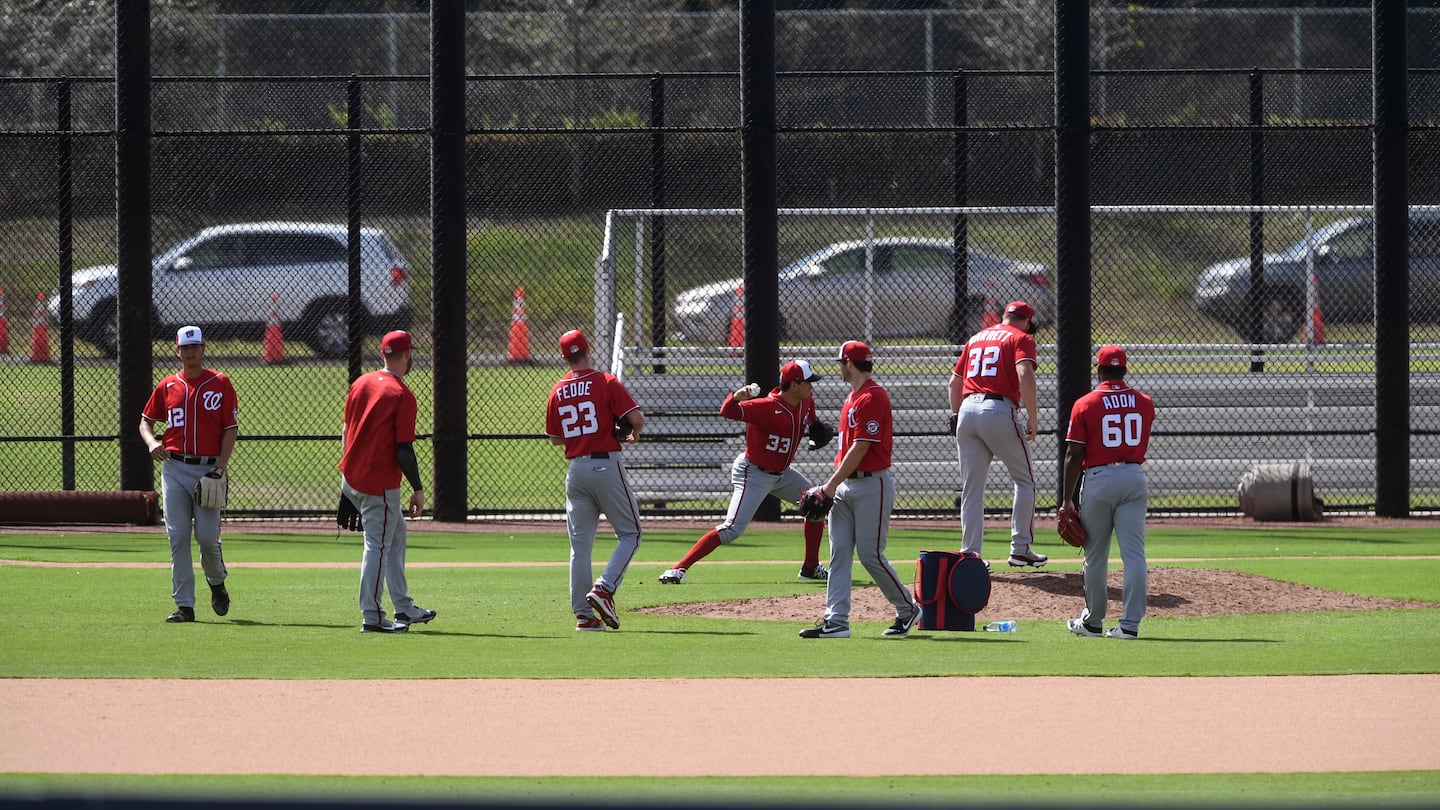The Nats can focus on baseball at spring training, but a reminder of the pandemic is nearby

A pickup truck slowed, creating a slight jam, and the driver ashed a cigarette onto the one-lane road that bridges the entrance to a row of white tents. Then he tapped the gas.
And nearby, inside the bounds of the same facility, the Washington Nationals prepared for another season amid the global pandemic. On Tuesday, during the team’s first full-squad workout, people faced close to an hour’s wait at the county’s largest public testing center. There was gridlock in a parking lot normally used by fans who want a glimpse of their favorite team. The contrast is sharp because it illustrates, in plain view for the Nationals, that this reality — this new version of “normal” — will soon reach a full year, and tests are still far more attainable for professional athletes than the average person.
It’s the present clashing with a more hopeful future. For the Nationals, it is hard to ignore.
“It is a reminder that this is still real,” left fielder Kyle Schwarber said. “That, you know what, people are still affected.”
“It’s reality,” first baseman Josh Bell explained. “We come into work every day, and it’s our little recess. It’s a step away from the real world, but you know how dangerous this virus is. You know how dangerous it can be being out in the public.”
Some days, as he walks out to Field 6 to stretch, Schwarber turns and asks, “How’s the line looking this morning?” It fluctuates with few hints of a pattern, said Matt Slatus, the ballpark’s general manager. The site was fully operational by late March. It was jam-packed after the holidays. Tuesdays are typically busy because there are no tests on Sundays and Mondays.
Otherwise, though, there’s the random hour when cars stretch out to Haverhill Road and down the block. Or, every so often, drivers can pass through with limited braking. That’s when the 100 or so workers — including health-care staff, local police and firemen, security and National Guard members — can get some respite.
Nationals players, coaches and staff are tested every other day as part of Major League Baseball’s health and safety protocols for 2021. MLB announced Friday that, among 20,742 tests conducted since spring training began this month, there were 20 positive results. West Palm Beach, like many parts of Florida, has seen a high volume of cases across the past 11 months.
“There’s a whole lot of people who’ve done a whole lot of work to make these things happen, but everyone knows what the mission is and why you’re out there,” Patrick Rutter, an assistant county administrator for Palm Beach County, said of the testing site at the Nationals’ and Astros’ shared facility. “We’ll be very happy to break it down some day.”
The initial plan was a few hundred nasal swabs per day. Slatus recalled telling his staff to not fully clean up the concession stands, figuring the stadium would be open again in a few weeks. But the county sprung into action, coordinating with the Nationals, Astros, the ballpark and the National Guard to start a site between the turnpike and Interstate 95.
That location, Rutter explained, made tests available to residents from around the city and its surrounding communities. At first, the testing happened on the southernmost edge of the facility. Then it moved to the middle of the complex, closer to the ballpark at its center, to keep cars from spilling onto the road. It switched back recently as the teams returned for workouts.
The security guards at the main entrance are conditioned to ask everyone whether they are looking for a coronavirus test.
“It’s not that we’re not aware of what’s going on, because we’re certainly reading the news and watching the news every day,” Slatus said. “But it’s a constant reminder that there is still work to be done.”
For months, the two blinking signs on Haverhill Road told drivers where to turn for a test. The cars were sorted into two lanes based on whether people had an appointment. Those getting tested wrote down their information and fished out identification. And if they peered at the complex, at the palm trees and tall lights, there was no Kyle Schwarber wondering how long their wait would be.
But those signs have shown a fresh message in recent days. There is advertising for fan parking. There’s a reminder that no cash is accepted. The testing is mixed with baseball now, a spot of progress in a time that has made hope feel like a trap.






